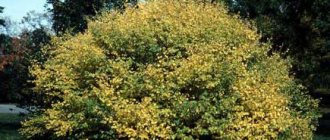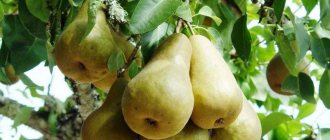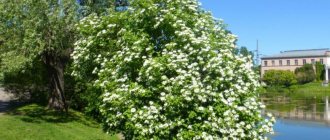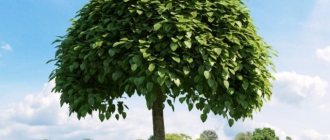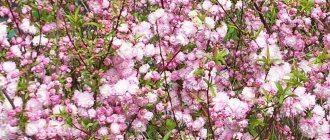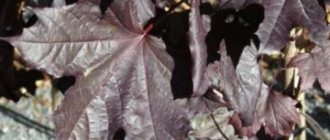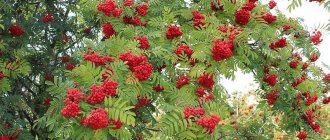The woody (woody) deciduous plant viburnum viburnum (more often called red viburnum) is a species of the genus Viburnum (in Latin - Viburnum), which is part of the relatively small family Adoxaceae (Adoxaceae). Edible fruits and, in addition, the bark have found use in folk (alternative) and scientific medicine. Previously, the genus Viburnum viburnum had the status of its own family Viburnaceae or was part of the Honeysuckle family (Honeyworts - lat. Caprifoliaceae). Why red viburnum is useful and what it treats we will find out in this article.
Viburnum photo in the picture:
Description
Where does viburnum grow?
Photo of viburnum bush:
Viburnum grows in natural conditions in the form of a small tree or shrub. Viburnum shrub reaches a height of 4 meters. The bark is gray with a brown tint. Longitudinal cracks are clearly visible on it. Viburnum leaves:
- petiolate
- entire or jagged
- whole, lobed or palmate-lobed
- simple
- falling
- opposite, sometimes whorled.
Viburnum leaves photo in the picture:
What does viburnum look like?
The inflorescences are a set of heteromorphic flowers of white or pink color, have an umbrella shape and are located on the tops of young branches. The flowering period is as follows: the last ten days of May – the first days of June. Viburnum berries are drupes with a bright red shell, oval or spherical in shape, reaching no more than 10 mm in diameter, on average 8 mm. Their ripening period: late August – mid-September.
Viburnum berry photo:
Nutritional value
Red viburnum is widely known and used in medicine. The raw materials are:
- bark (Cortex),
- flowers (Flos),
- fruits (Fructus viburni),
And the pharmaceutical raw material is the bark – Cortex Viburni opuli (prunifolii).
The active ingredients of viburnum are as follows:
- flavonoids (astragalin, quercetin, amantaflavone, kaemferol);
- tannins (approximately 6-7% in bark);
- triterpenes (alpha and beta-amyrin, oleanolic acid, ursolic acid);
- coumarinates (scopoletin, esculetin);
- essential oil;
- glycoside (viburnin);
- phytosterols (beta-sitosterol);
- phenolic alcohols;
- phlobafens;
- phenolic acids (salicylic acid);
- valeric acid;
- pectin;
- formic acid;
- acetic acid;
- caprylic acid;
- viburnitol (cyclitol);
- resin 6-6 5%.
The fruits also contain:
- saponins;
- tannins (3%);
- sugar (32%);
- pectin;
- tannins;
- carotene;
- vitamins C, K, P;
- catechin tannins;
- coumarin compounds;
- carotenoids;
- saponins;
- Ca, Mg, Fe;
- mineral salts.
The bitter taste of the berries is given by a glycoside called viburnin. This active chemical compound protects the human body from various types of infections, having antibacterial properties.
Valeric acid, which is part of viburnum, has a calming effect on the nervous system.
Viburnum bark contains:
- organic acids;
- tannins;
- resins;
- coumarin compounds.
Types and varieties
Let's name only popular types of viburnum
- Red viburnum. This species has firmly taken its rightful place in culture as a plant characterized by a unique decorative effect and capable of producing a rich harvest of juicy fruits. Viburnum berries have medicinal properties and their use is beneficial. Photo:
The following varieties of red viburnum are among the well-established ones:
- Vigorovskaya. The fruits have a slightly bitter sour taste. The variety is productive.
- Elixir. This is a slightly spreading viburnum bush, reaching a height of up to 3 m. Its bright burgundy-colored berries have a sour-sweet taste that is not dissonant with moderate bitterness.
- Zholobovskaya. The slightly elongated berries have juicy, slightly sweet, but at the same time slightly bitter pulp. Red viburnum has beneficial properties.
- Taiga rubies. This variety is characterized by increased productivity. Its round fruits with a dark red shell have a sweet taste with a characteristic sourness and barely noticeable bitterness.
- Maria. The viburnum bush of this variety is vigorous. Viburnum red berry is slightly tart with the same sour-sweet taste.
- Shukshinskaya. There is no need to talk about the origin of the name. The variety is productive. The ripening period is average. The viburnum fruits of this variety are spherical in shape and bright red in color.
- Garnet bracelet. Also a productive variety. The ripening period is late. The oval-shaped berries are dark burgundy in color and covered with a dense shell. The viburnum bush of this variety, although medium-sized, is very spreading.
- Viburnum rugosa. In its natural environment it lives in the Central and Western Provinces of the People's Republic of China. This is an evergreen shrub up to 3 m high and has original leaves (see photo).
Viburnum of this species looks great not only in single plantings, but also in groups with a small number of individuals.
- Viburnum laurelifolia. This shrub, reaching a height of 3 m, is common in Mediterranean countries. The berries are spherical in shape, approaching egg-shaped, and are characterized by a black color with a blue tint. Viburnum berry benefits and the appearance of the viburnum leaves of this variety, which have an elliptical shape, is especially attractive. On the top side they are:
shiny
bright green
entire
leathery
Viburnum leaf photo:
The underside of the foliage of the viburnum laurel bush has lighter shades and pubescence is clearly visible on the veins.
- Viburnum gordovina. This species is not similar to common red viburnum. This bush, reaching a height of considerable 5 m, has a dense, non-spreading crown. A cover of white, star-shaped hairs is clearly visible on the branches and leaves. Very attractive-looking wrinkled leaves of quite a decent length - up to 18 centimeters:
wide
dense to the touch
dark green on top
grayish-felt underneath
Viburnum berries are ordinary drupes, the shell of which changes color from red to completely black as it ripens.
- Viburnum sargent. The viburnum bush of this decorative variety has a powerful branched crown, as well as a large number of side shoots.
The inflorescences of viburnum sargent reach a diameter of approximately 3 cm. They bloom in May. The fruit ripening period is mid-autumn. The berries are usually red in color and relatively small, but there are exceptions.
Benefit
The fruits contain vitamins K, A, E, C, tannins, organic acids, essential oils, tannins, polyphenols, potassium, iron, zinc, pectins. The berries contain plant substances that are very similar in composition to the female hormone estrogen. Viburnum tones blood vessels, relieves pain, normalizes the functioning of the heart muscle, promotes blood renewal, reduces the risk of anemia and atherosclerosis, and reduces heart pain. The fruits are used to unclog blood vessels and clear cholesterol plaques. The fruits are useful for people with digestive problems, gastritis and colitis.
Viburnum seeds are taken orally when recovering from serious illnesses; they reduce pain during migraines, increase performance, elevate mood and reduce fatigue. Decoctions from the bark stop bleeding and are used in the presence of long-term non-healing wounds and surgical sutures.
Not only the fruits of viburnum are useful, but also flowers, young shoots, and leaves with bark. Regular consumption of fruits helps to cope with depression, stress, insomnia, and get rid of nervous tension. Fruits strengthen the immune system well.
Properties of viburnum berries:
- choleretic
- astringent
- antimicrobial
- antispasmodic
- sweatshop
- expectorant
- anti-inflammatory
- restorative
- diuretic
- sedative
- painkiller
Landing
Planting, as well as subsequent care of the beautiful viburnum, is usually not difficult. Grows well on soils with a pH in the range from 5.5 to 6.5 (neutral or slightly acidic soil). But sandy soils, podzolic soils (previously called belozem) and peat-bog soil are not at all suitable for viburnum. In addition, it is desirable that in the plot where it is intended to be planted, the first aquifer from the surface of the earth lies at a depth of no less than 1 m.
Medicinal properties of red viburnum in the photo:
Planting in spring
Planting red viburnum in the spring involves the following sequence of actions:
- Before leaves appear on the plant, a hole is dug with a diameter and depth of 50 cm. When you plan to plant several bushes, the holes should be positioned so that the distance between them is from 2.5 to 3.5 m.
- A soil mixture is formed from:
- the top layer of soil removed from the planting hole;
- 2 glasses of complex fertilizer “Nitrophoska”;
- 1 bucket of dry peat or plant humus.
- After thoroughly mixing the mixture, fill the hole 2/3 with it.
- Up to 4 buckets of ordinary water are poured there. All this is left for about a week
- After 7 days, part of the remaining soil mixture is poured into the hole in a mound so that its top point is 10-12 centimeters above the surface.
- The roots of a 3-year-old seedling are located on this hill and neatly straightened along its sides.
- The hole is filled with the remains of the soil mixture.
- The plot surface located close to the seedling:
- compacts;
- watered abundantly;
- mulched with rotted humus, black peat or organic compost.
It is necessary to control the location of the root collar. It should be 5-6 centimeters above ground level.
Planting in autumn
The procedure for planting red viburnum in the autumn season is similar to that described above. It is performed when the plants finish shedding their leaves, but before the first frosty days.
Photo of viburnum in autumn:
Recipes
Viburnum jelly
Ingredients:
- 2 glasses of water;
- 1 kg viburnum;
- 800 g sugar.
Preparation:
- Rinse the fruits in a colander under running water.
- Place the berries in boiling water for 5 minutes to soften them and lose their bitterness.
- Grind the viburnum through a sieve, add water and sugar to the juice. Mix thoroughly.
- Simmer over low heat for 50 minutes until well thickened.
- Pour the jelly into jars and store in the refrigerator.
Viburnum sauce for meat
Ingredients:
- 3 cloves of garlic;
- 5 sprigs purple basil;
- 6 sprigs of dill;
- 300 g viburnum;
- 2 tbsp. l. Sahara;
- 200 ml water;
- 1 hot pepper;
- 3 pinches of salt.
Preparation:
- Rinse the berries, place them in a saucepan and cover with water.
- Cook over low heat until it boils.
- Reduce heat to low and cook berries for another 15 minutes.
- When the viburnum has cooled, grind through a fine sieve.
- Place the sauce over low heat, add crushed garlic and chopped pepper.
- Finely chop the greens and add to the mixture, add sugar and salt.
- Mix the sauce well and bring to a boil, keep on low heat for another 5 minutes.
- Pour the finished sauce into a jar.
Viburnum care
Caring for viburnum does not cause difficulties even for novice gardeners. However, you need to know the basic rules.
Viburnum bush photo in the picture:
Spring care
In the last days of March or in the first ten days of April, last year's fallen leaves are removed from the surface of the tree trunk circle, and the soil is loosened. After a short period of time, the viburnum bush must be treated with a drug that prevents fungal diseases - urea. By the way, this substance also successfully plays the role of highly effective plant nutrition. However, before you start spraying the viburnum bush, you should definitely make sure that the buds on the branches have not yet begun to open, because in this case, they can simply be chemically burned.
Further care includes:
- fertilizing in the second ten days of May with fertilizers containing potassium;
- application of soil around the tree trunk after the end of the flowering period of complex complex mixed fertilizers.
What does Kalina help with? Photo:
Summer care
After flowering has finished, the viburnum bush must be inspected regularly. If pests are found, control must be started immediately. The same approach applies to identified diseases. To get rid of fungal infections you can:
- in early June, treat the plant with tobacco decoction;
- from the beginning of summer until harvest time, spray viburnum with infusions:
garlic or onion peel;
potato tops
Otherwise, caring for the viburnum bush in the summer involves regular watering, loosening the soil around the tree trunk, accompanied by the removal and subsequent inevitable destruction of emerging weeds.
Autumn care
After the leaves fall from the viburnum, they must be removed simultaneously with the mulch. Treatment should also be carried out for preventive purposes, aimed at protecting against microorganisms that cause diseases, and against the actions of possible pests that “decided” to overwinter in the viburnum bark and in the soil. At the final stage, at the discretion of the gardener, one of the following actions is carried out:
- Liquid fertilizer is applied to the soil;
- the tree trunk circle is mulched with fairly well-rotted organic matter.
With the arrival of stable frosts, bunches of berries are removed from the viburnum bush, then they are placed for storage in a place with suitable conditions and retain the beneficial properties of viburnum.
Treatment
With the arrival of spring and the onset of autumn, viburnum is processed:
- insecticides – preparations that destroy harmful insects;
- fungicides - compounds that fight fungal diseases.
Unfortunately, it is impossible to cure this plant from bacterial and viral diseases. Therefore, the emphasis must be placed on preventing infection of the viburnum bush. This goal can be achieved only by the timely extermination of insects that carry pathogens, as well as their voracious larvae.
Watering
In hot, rainless weather, viburnum should be watered at least once a week. Under one fruit-bearing bush, you need to pour 3 to 4 buckets of water in one approach. Young shrubs require less moisture, but the frequency of watering remains the same.
Summers with heavy rainfall affect the frequency of this activity. But it should be borne in mind that viburnum bushes are lovers of moist soil, so not only making them “suffer from thirst,” but even depriving them of life-giving moisture for a short time is not recommended.
Top dressing
It is advisable to feed with dry fertilizers, pouring them onto the surface of the tree trunk circle before the next watering.
- The first feeding is done in the spring when the leaves bloom. Under the viburnum bush, urea is scattered in the amount of 2 tablespoons. But this is provided that branches with buds that have not yet awakened were not sprayed with this drug.
- For the second feeding, potassium-based fertilizers are used. It is carried out before flowering. Then pour under the viburnum bush:
wood ash - a half-liter jar is enough, or;
Potassium sulfate - 2 tablespoons.
- The third feeding is carried out at the end of the flowering period: modern fertilizer “Nitroammofoska” in the amount of 2 tablespoons is scattered under the bush.
- The last fertilizing is required only if the gardener does not carry out the procedure of mulching the soil near the tree trunk with organic compounds for the winter. It includes:
superphosphate - in the amount of 2 tables. spoon;
potassium sulfate - the same 2 tablespoons.
These components must be dissolved in 10 liters of cold water.
Morphology, biology
Botanical name of viburnum: Viburnum vulgare. Aka: red viburnum.
Scientists are working on classification and changing the names of some families. Or they move plants to other groups based on identified characteristics.
For a long time, viburnum was one of the honeysuckles, but now it has been separated from this family into another: adoxaceae.
The name of the family is not important: viburnum remains the same.
This is a long-lived (half a century old) shrub with a variety of species in height. It can be low - one and a half meters, or it can grow up to four meters.
Even one species exposed to different conditions manifests itself differently.
A viburnum seed that falls into a deep crevice in the soil landscape will grow into a plant many times larger than one growing on an open surface.
Plants are drawn to the light. Where it is lacking, the upward growth of viburnum will be enhanced. A viburnum tree may grow. If there is enough nutrition and moisture.
The bark is smooth only on young light brown shoots. Later they acquire a gray tint and become covered with cracks (“shaggy”).
More often the shoots are rounded, sometimes they can be ribbed. If you need to verify from a young bush that it is viburnum, cut the shoot.
It shows a reddish hexagon-shaped core.
Viburnum has two types of shoots. Some are fruitful, others are barren. They can be distinguished. Consider the terminal buds.
On sterile ones, one bud is located in the center of the end of the shoot. Fruitful ones are crowned with two buds. Between these buds a growth point is visible: the tip of the shoot.
The leaves are large, up to 10 cm long, with blades, the shape resembles a maple leaf, but the outline is a little softer, and the plate itself is a little thicker.
The color is intense green, dark, the leaves are wrinkled. The leaves at the bottom of the plate are often pubescent and differ in color from the upper side: they are greyish.
The viburnum becomes red all over before the leaves fall. Its leaves turn intensely red in the fall, completing the growing season.
Flowers are very decorative. Umbrella-shaped white panicles are elegant; when the viburnum blooms, it is strewn with them, as if doused with white foam.
She is beautiful in any period, including the rest period. In winter, bare shoots adorn the fruits: drupes of bright red color, visible from a distance against the background of snow.
Drupes can reach a centimeter in diameter.
The fruit tastes bitter, but after frost, viburnum partially loses its bitterness and becomes softer in taste.
The seeds are flat round seeds and remain viable for a maximum of two years.
Viburnum is photophilous and tolerates partial shade. Does not form berries in the shade. It gravitates toward moderate moisture and does not tolerate drought or excess moisture.
Nutritional requirements are average, a golden mean in everything. It does not like overfeeding, but if it finds itself on poor soils it can grow frail.
In different regions, in the area where conifers grow, it likes to settle next to them. Often found in combination with pine, fir, spruce.
Many deciduous trees are also good neighbors of viburnum, especially oak, hornbeam, alder, and poplar. Does not shy away from birch and aspen, growing nearby.
In the steppe zone, viburnum looks for where it is moister and settles in floodplain areas of rivers.
The plant is cross-pollinated; for good fruit set, clear, windless weather is needed, plus the work of insects.
The largest, most beautiful flowers are located at the edges of the inflorescence. They are sterile and serve as bait: they are visible to insects from afar.
The root system of viburnum is well branched and tends to sprout. It does not penetrate very deeply, up to half a meter.
Relative to the above-ground mass, the underground is rather weak. The roots are quite capable of feeding and holding the plant.
But if viburnum is planted in a region where summer heat is common and where there are dry periods, it becomes vulnerable.
Under such conditions, the top soil layer dries out quickly. In the absence of rain, viburnum may even die and dry out on the vine.
Moisture is needed in moderation, but always. The structure of the viburnum root does not allow it to be extracted from deep soil horizons.
Viburnum does not crumble. If desired, if the harvest is large, you can share it with the birds, picking off the tassels right in the winter, if necessary.
Determine some of it into blanks, leave the rest on the branches.
Birds rarely peck the entire crop; usually the birds have enough to eat, and the owners of the garden have enough to feast on more than once.
Pruning viburnum
Regardless of what type of viburnum grows in your garden plot - a tree or a shrub, it is better to prune it in the spring before active sap flow begins. This procedure can also be carried out in the fall, when the leaves have fallen from the plant. However, due to the fact that it is practically impossible to know 100% the day of the arrival of severe frosts, it is recommended to carry out formative pruning or rejuvenating haircuts in the spring. And in the autumn season it is better to carry out this procedure, pursuing sanitary purposes.
Pruning in spring
With the arrival of spring, before active sap flow begins, sanitary pruning is first carried out, after which a formative haircut is performed. So, if you want to grow viburnum in the form of a tree:
- only 1 vertically directed branch is left;
- the rest are cut out in accordance with the so-called. “on-ring” technology;
- where there is a trunk, but only in the lower segment of the stem, the buds must be removed.
The period of time during which the trunk is removed is about 2-3 years. And when it reaches a height of about one and a half to two meters, the growth point, in order to stimulate branching, must be pinched. During this entire time interval, the gardener must wage, as they say, an irreconcilable fight against root growth. otherwise, it will not form a tree, but a viburnum bush. Particular attention should be paid to the cleanliness of the trunk: newly formed side shoots must be removed immediately.
It doesn’t matter what type of plant is being grown - it could be a viburnum tree or the same shrub - it will still have to be pruned. This requirement has not only a decorative, but also a purely practical basis. From an overly thickened and branched crown, picking fruits will cause considerable difficulties, and, in addition, the number of berries will noticeably decrease, and their quality will gradually, however, quite noticeably deteriorate.
Shoots and branches to be removed:
- growing:
in the wrong direction;
inside the bush
- rival
Anti-aging pruning is performed as follows:
- about 1/3 of the old branches are cut off;
- Only those shoots that have developed sufficiently well are left from the root shoots. Over time, they will replace the old deleted branches;
- in the second and third years, a third of the old branches are also replaced
That is, the viburnum bush will rejuvenate within a full 3 years.
Pruning in autumn
After the leaves of the viburnum fall off and enter a state of hypobiosis (as forced dormancy is scientifically called), the gardener must carry out sanitary pruning. This event involves the removal of branches and shoots:
- affected by pests or diseases;
- dried out;
- broken
Sections whose thickness exceeds 7 mm are treated with garden varnish. It is recommended to carry out pruning on a warm day, without any precipitation.
Application in medicine
A decoction of the bark of the plant with honey and sea buckthorn oil is very effective for colds. The drink can be taken as a means to prevent such ailments. For sore throat, gargle with viburnum decoction or make compresses. Berry juice helps with skin diseases, boils, and dermatitis. A decoction made from flowers is effective for loss of voice and periodontal disease. If you have a nosebleed, soak cotton swabs in the broth and insert them into your nostrils. Frequent consumption of fruits is a good prevention of cancer.
The berry is widely used in cosmetology; masks, tonics, cleansers, scrubs, and shampoos are made from it. After using products with viburnum, the skin becomes more velvety, rejuvenated and moisturized.
Viburnum copes with various ailments of the human body:
- endocrine diseases
- mastopathy
- severe menopause
- uterine bleeding
- irregular menstrual cycle
- painful menstruation
- angina
- hypertension
- bronchitis
- acute tonsillitis
- headache
- heart diseases
- skin diseases
- hysteria and neurosis
- fever
- cold
- haemorrhoids
- dyspnea
- flu
- sclerosis
- severe dry cough
- eczema
- diathesis
Reproduction
Viburnum reproduces in several ways. Let's consider them
Seed propagation
This method is complicated because viburnum seeds have the following property: it takes 2 years to germinate. To speed up this process, the following actions are taken with them:
- Seeds, freshly taken from ripe berries, are placed in nylon stockings slightly filled with damp sawdust.
- Seed material is stored for 2 months indoors at room temperature.
- Having noticed that the seeds have begun to germinate, the gardener should place them in the lower chamber of the refrigerator.
- A month later they are sown in wooden boxes with soil. In this case, it is necessary to ensure that the seeds are located at a depth ranging from 3 to 4 cm.
- Next you should wait for the seedlings to appear.
- In the spring, after the end of the period of return frosts, the seedlings are carefully transplanted to the site without any protective cover.
- Subject to abundant watering.
It is very important in the first time after planting in open ground to shade the seedlings from direct solar radiation.
Reproduction by vertical layering
This method of propagating red viburnum, useful properties and contraindications, involves going through the following stages:
- the lower branches of a young plant are shortened so that at least 2, but not more than 4 buds remain on them;
- the stem is then hilled to a greater height;
- in the spring, after waiting for the shoots from the buds to reach a length of 8-10 centimeters, they are once again subjected to hilling, this time to a certain height: its value should range from 4 to 5 cm;
- Having allowed the shoots to grow up to 25-30 cm, the gardener must partially remove the soil from under the seedling and tightly tie it with copper wire at a level in the immediate vicinity of the base;
- another hilling is carried out at approximately 1/3 of the height;
- this procedure is performed again after 2 weeks;
- when autumn comes, shoots:
dig up
carefully separate
transplanted to a permanent place allocated to them on the site
Propagation by cuttings
The optimal timing for this method of propagating viburnum is the flowering period, which usually lasts from mid-June to the 1st decade of July. The material for cuttings is the middle section of the shoot, which has up to 3 nodes, and its length should be from 10 to 12 cm. There are other requirements, namely:
- the lower cut is oblique;
- leaves:
the top ones are shortened by half
lower ones - removed
This method of reproduction is implemented as follows:
- The lower cut of each cutting is dusted with fine powder “Kornevin”, or kept for up to half a day in a solution of such a powerful growth stimulator of planting material as “Heteroauxin”.
- The cuttings are planted in a pre-prepared substrate, including one equal part each of black peat and sand (preferably river sand). Landing requirements:
cuttings are placed at an angle;their depth level
is only 1 to 2 cm; the distance between samples is from 4 to 5 cm. - The planted cuttings are covered with a transparent film and kept under the following conditions:
air temperature within 27-30 degrees C;humidity - approximately 90%.
- Throughout the day, the cuttings need to be moistened with water from a spray bottle up to 4 times.
- Having allowed them to take root (this will happen in about 3 weeks), the gardener should begin to remove the dome from the film for a short time.
- When the cuttings become accustomed to the environment, the dome is removed forever.
- The cuttings overwinter indoors.
- With the arrival of spring, they are subjected to 2-week hardening.
- Then they are planted in an area without shelter. Planting pattern - 50×15.
- After growing, the seedlings are transplanted to the permanent place allocated to them on the plot.
Reproduction by horizontal layering
The sequence of stages of this method of reproduction is as follows:
a branch of two or three years of age is shortened in the spring so that about 2-4 buds remain on it;
a year later, also with the arrival of spring, the regrown 1-year-old shoot is cut off by 1/5, bent to the surface of the earth, placed in a small furrow, the depth of which does not exceed 6 cm and fixed with hooks;
This groove is sprinkled after the shoots that emerge from the buds become 10-15 centimeters high. For this, a mixture of plant humus and black peat is used. In this case, the following point is subject to control: the tops of the branches should not be covered, but should be located on the surface;
growing shoots throughout the summer season are subjected to hilling 2 or even 3 times;
with the arrival of autumn, the buried branch is separated as carefully as possible from the mother viburnum bush, the shoots that have taken root are cut off from the cuttings and finally planted in the permanent place allocated to them on the land plot.
Reproduction by root shoots
The base of the basal 20-centimeter processes at the end of the spring or early summer is tied with soft, for example, copper wire. Then these shoots are hilled to a height of up to 8 cm. This procedure is repeated throughout the summer 2-3 times, so that the final height of the hill is 20 cm. And the shoots are separated from the viburnum bush and replanted with the arrival of next spring.
Diseases
Below are the most common diseases of viburnum.
Fruit rot
The defeat of this disease leads to wrinkling of the shell of the berries, drying out of even young shoots, inflorescences and, first of all, viburnum leaves. The gardener, having noticed the symptoms of the disease, must treat the plant with the contact fungicide “Copper Oxide” or a well-proven Bordeaux mixture.
Gray rot
Signs of the disease are that in rainy and cool summers, large brown spots with vague outlines appear on the leaves of the viburnum. Their size quickly increases, and the spongy pulp of the leaf dries out to such an extent that it cracks. When the foliage falls, it will need to be collected and burned; the plant itself is treated with the therapeutic and prophylactic fungicide Vectra.
Ascochyta blotch
On the affected leaves of the viburnum bush, gray spots of various shapes appear - from round to irregular polygonal - with a deep purple or dark brown frame. Then, on the tissue that dies at the site of the spots, the reproductive bodies of carriers of the fungal disease are formed. With fallen leaves, the same procedure is carried out as in the previous version, only the plant must be treated with the same preparations as for fruit rot diseases (see above).
Powdery mildew
The signs of this disease are as follows: on the leaves of viburnum, no matter whether it is a tree or a young shrub, a grayish coating with small droplets of liquid forms, which over time acquires a brown tint. The affected plant stops bearing fruit. The following fungicides are used for control:
Byleton
Quadris
Topaz
Tiovit Jet
Topsin
Score
Contraindications
Viburnum fruits contain poisonous saponins. After ingestion in large quantities, they cause side effects - vomiting, dizziness, speech impairment, loss of consciousness.
Children are most vulnerable to the side effects of viburnum. Therefore, they can eat viburnum only after processing, for example, in the form of jams, marmalade, juices or tinctures and in limited quantities. Pregnant and lactating women should use such drugs and tinctures with caution, only after consulting a doctor.
Berries should be consumed after freezing (24 hours) and after heat treatment, then they lose their bitterness and their toxic properties resulting from the content of saponins.
Raw viburnum causes gastrointestinal disorders, painful diarrhea, and headaches.
People suffering from stomach acidosis and chronic kidney disease should be careful with viburnum tincture.
Pests
The most dangerous pests of viburnum, including common viburnum, include:
Green lollipop
It is a green-yellow caterpillar that destroys flower ovaries, completely gnawing them out. An effective means of control is a 10% solution of the well-known insecticide “Karbofos”.
Viburnum leaf roller
Also a caterpillar, but sandy or dark gray in color. She first entangles the buds in a web, crumples them, and finally eats them. The same fate awaits the leaves of viburnum affected by this pest. The fight against it involves treating a bush or tree before the buds begin to bloom with the complex preparation “Nitrophen”, 250 grams of which must first be dissolved in 10 liters of cold water.
Viburnum leaf beetle
The larvae of this beetle with a light brown shell eat the leaves so thoroughly that only veins remain. Having discovered oviposition, the viburnum bush should be treated with the popular insectoacaricide Fufanon or the equally popular drug Karbofos.
